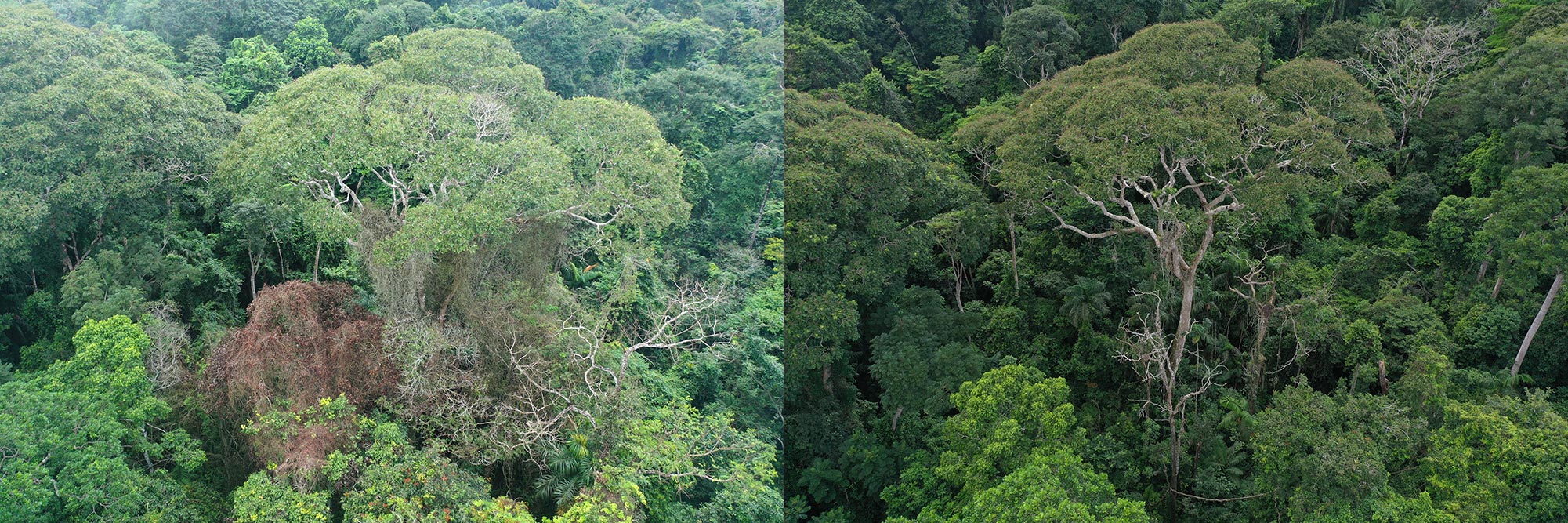Lightning is usually seen as a harbinger of destruction in forests, killing or damaging trees in their blasts. But in the lowland rainforests of Panama, one species of towering tropical tree may have evolved to use this force of nature to its advantage.
The tonka bean tree (Dipteryx oleifera) may actually benefit from being struck by lightning, according to a new study.
Scientists discovered that these trees not only survive these electrical encounters unscathed, but the lightning damages its competitors and the parasitic vines that cling to the tonka bean trees. The researchers published their findings March 26 in the journal New Phytologist.
“We started doing this work 10 years ago, and it became really apparent that lightning kills a lot of trees, especially a lot of very big trees,” study lead author Evan Gora, a forest ecologist at the Cary Institute of Ecosystem Studies, told Live Science. “But Dipteryx oleifera consistently showed no damage,” Gora said.
In tropical forests, lightning is a major cause of tree mortality — especially among the largest, oldest trees that play key roles in storing carbon and supporting biodiversity.
Understanding how lightning shapes forest structure and species composition could shed light on how resilient these ecosystems are in the face of climate change. But amid the destruction, the researchers noticed something surprising: one species seemed to be thriving.
Using a custom-built system of electric field sensors and cameras to track strikes, researchers studied nearly 100 lightning events in Panama’’s Barro Colorado Nature Monument.
Related: ‘Gossiping neighbors’: Plants didn’t evolve to be kind to each other, study finds
To track the exact points where lightning bolts struck, the scientists developed a high-resolution detection system. An antenna array, placed throughout Central Panama, detected radio waves from lightning strikes. By analyzing the energy patterns recorded by each sensor in the array, the researchers could triangulate the strike with high accuracy.
When combined with on-the-ground surveys and drone imagery, the team could pinpoint the forest area that was struck and monitor the condition of the trees over time.

The researchers found that D. oleifera stood out as a species that consistently showed little to no damage after being struck by lightning.
To get a longer term picture of the effect of lightning strikes on tonka bean trees and their neighbors, the team analyzed decades’ worth of tree plot records.
“Over those 40 years, there’s a quantifiable, detectable hazard of living next to Dipteryx oleifera. [As a tree], you are substantially more likely to die than living next to any other big old large tree in that forest,” Gora said.
On average, each lightning strike killed more than 2.4 tons (2 metric tons) of nearby tree biomass and nearly 80% of the lianas (parasitic vines) that infested the tonka bean’ canopy.
Gora speculated that the key behind these trees’ lightning resistance comes from their physical structure. Past studies suggested that the tree has high internal conductivity, enabling lightning current to flow through without building up damaging heat — like a well-insulated wire.
Because it tends to grow large — up to 130 feet (40 meters) — and live for centuries, a single tonka bean tree is estimated to be struck at least five times after reaching maturity, with each strike helping to clear out vines and competitors, opening up the canopy to help it thrive.
The researchers estimated being struck by lightning could result in a 14-fold increase in lifetime seed production, giving the species a major reproductive advantage.
Gregory Moore, a horticulturalist from the University of Melbourne who was not involved in the study, said that the findings likely apply to other species as well. “The sort of work could also apply to other tree-dominated plant communities such as woodlands or low woodlands where trees are widely separated, so nothing like a tropical forest,” he said, adding that other tall trees are also likely targets of lightning strikes.
“We have long known that some trees can survive multiple lightning strikes,” Moore said, pointing out that some tall trees survive Australian bush fires and end up towering over their neighbors, which makes them prime targets for lightning strikes.
“They are often referred to as stags because the top of the crown has been blown out, but they can survive for centuries after being hit by lightning,” he said.
Gora and colleagues are now expanding their research to other forests in Africa and Southeast Asia to find out whether lightning benefits other species.
